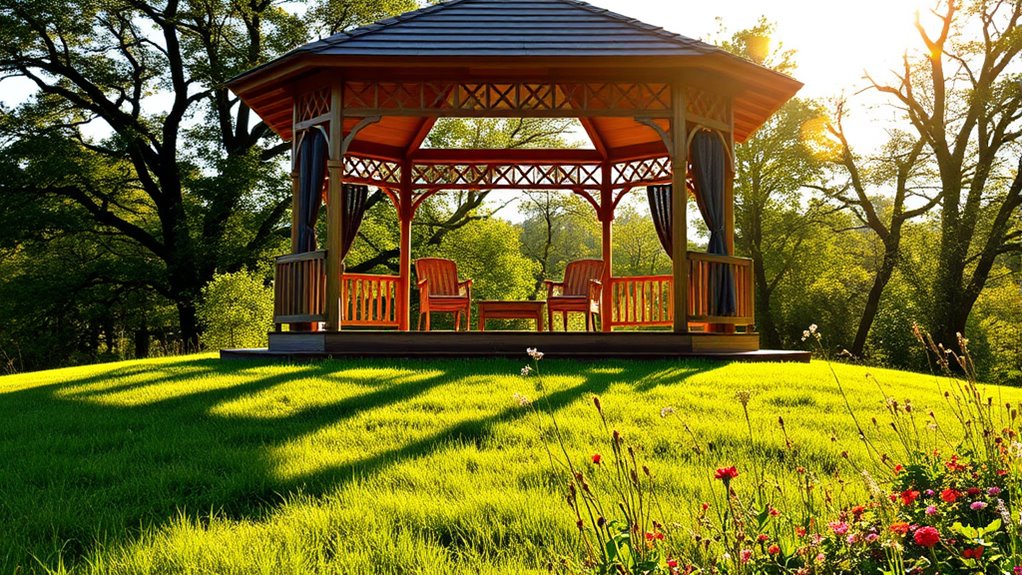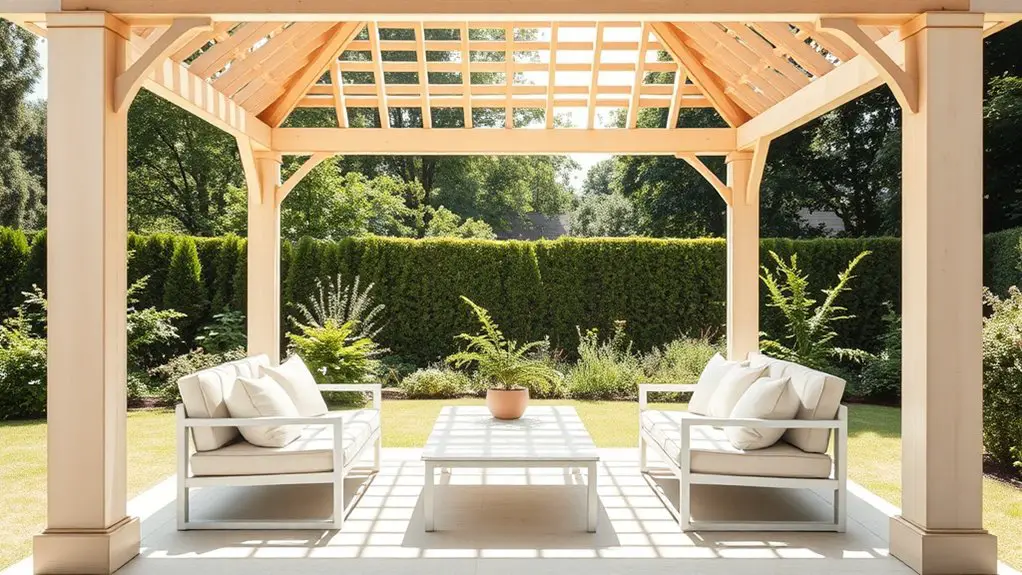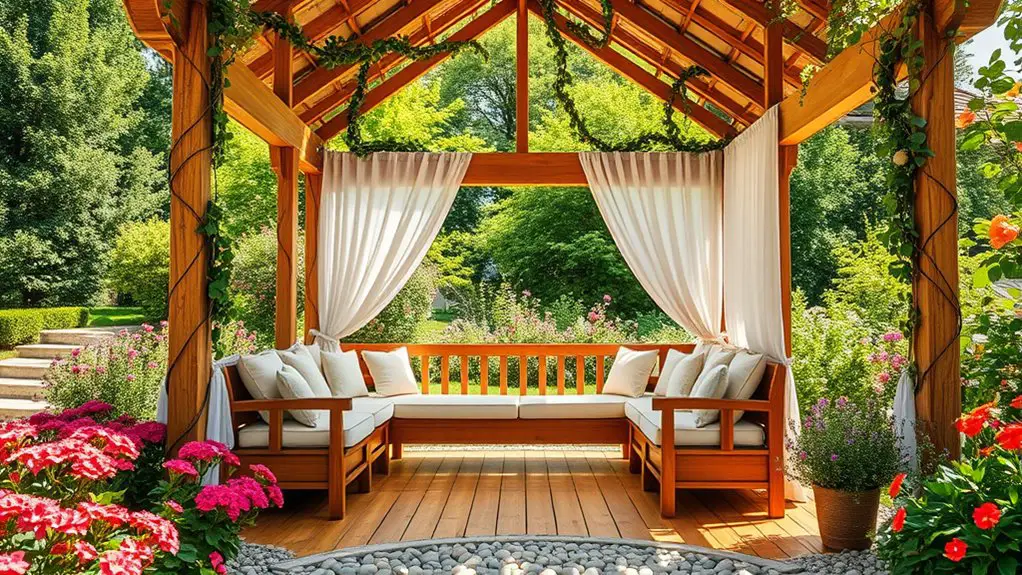To build a gazebo with an open, airy feel, start by selecting natural, sustainable materials that create warmth. Incorporate large windows and sliding doors for seamless connections with nature. Choose an elevated structure for better views and drainage. Design a light, airy roof with transparent panels for abundant sunlight. Opt for minimalist furniture to maintain serenity, and enhance the space with plants and soft lighting. Continue exploring ideas for achieving your ideal gazebo atmosphere.
Selecting the Right Materials for an Open Design

When selecting the right materials for an open design gazebo, it’s essential to evaluate both aesthetics and durability. Choosing natural materials like wood can create a warm, inviting atmosphere while blending seamlessly into your landscape. Opt for sustainable options, such as reclaimed timber or bamboo, which not only look beautiful but also minimize environmental impact. These materials provide strength and resilience, ensuring your gazebo withstands the elements.
Consider the finish, too—using eco-friendly stains or sealants can enhance the wood’s appearance, protecting it while keeping your space visually appealing. Incorporating a metal framework, like aluminum or treated steel, can add a modern touch and further bolster durability. Balance is key; combining these materials allows for an airy, open feel that invites freedom and connection with nature. By thoughtfully selecting your materials, you’ll create a stunning gazebo that’s both functional and sustainable, perfect for enjoying those serene moments outdoors. Additionally, proper material selection contributes to creating a comfortable outdoor experience that complements the landscape and home style.
Incorporating Large Openings and Windows
When you think about incorporating large openings and windows in your gazebo, imagine how they can transform the space into a seamless blend with nature. Expansive window designs not only enhance visibility but also create an open concept layout that invites fresh air and sunlight. This thoughtful integration allows you to enjoy the beauty of your surroundings while providing a comfortable retreat. Additionally, considering sun and shade exposure will help ensure the gazebo remains a pleasant space throughout the day.
Expansive Window Designs
There’s something undeniably intriguing about expansive window designs that seamlessly blend indoor and outdoor spaces. By incorporating large glass panels, you’ll invite expansive views of your surroundings, making your gazebo feel like an extension of nature. These windows not only enhance aesthetics but also provide natural ventilation, creating a revitalizing atmosphere. Picture wide openings that frame the sunset or a gentle breeze flowing through; it’s a feeling of freedom that invigorates the soul. Consider using sliding or folding glass doors to maximize accessibility and light. With careful placement, you can guarantee that every glance outside becomes a enchanting experience, allowing you to bask in the beauty of your environment while enjoying the comfort of your gazebo retreat.
Open Concept Layouts
Embracing an open concept layout transforms your gazebo into a harmonious blend of space and light, inviting the outdoors in. By incorporating large openings and expansive windows, you create open floorplans that enhance spatial flow, making the area feel larger and more connected. Imagine the sun streaming in, illuminating every corner while gentle breezes dance through the openings. This design not only encourages interaction but also fosters a sense of freedom, allowing you to enjoy nature from the comfort of your gazebo. Consider using sliding glass doors or wide archways to blur the lines between inside and outside, ensuring your space feels airy and inviting. With thoughtful placement, your gazebo can become a serene retreat that celebrates the beauty of your surroundings.
Choosing an Elevated Structure

When you think about elevating your gazebo, consider how height can enhance both its visual appeal and functionality. Elevation not only provides a commanding view of your surroundings, but it also helps with drainage and stability, making your structure more resilient against the elements. As you explore design options, remember to prioritize a solid foundation that supports your vision while ensuring safety and durability. Additionally, the ideal placement of your gazebo should be on flat, sturdy ground to ensure stability and longevity.
Importance of Elevation
Choosing an elevated structure for your gazebo not only enhances its aesthetic appeal but also offers practical advantages that can’t be overlooked. The elevation benefits include:
- Unobstructed Views: You’ll enjoy a panoramic vista, making every gathering feel special.
- Improved Airflow: The breeze dances around you, creating a revitalizing atmosphere on warm days.
- Less Moisture Exposure: Elevation keeps your gazebo drier, preventing rot and decay.
- Enhanced Privacy: You can feel secluded, surrounded by nature, while still enjoying an open environment.
With these elevated aesthetics, your gazebo becomes a luxurious retreat, inviting you to relax and unwind, surrounded by the beauty of your landscape. Embracing height truly transforms your outdoor experience.
Design Considerations for Stability
Designing an elevated gazebo requires careful consideration of its stability, as a well-structured foundation is essential to withstand the elements and provide safety. Start by selecting durable materials that enhance its structural integrity, like pressure-treated wood or steel. Incorporate stability features such as cross-bracing and diagonal supports, which help distribute weight evenly and resist swaying. Elevate the structure on sturdy piers or concrete footings to prevent settling and flooding. Guarantee the design allows for proper airflow, keeping the atmosphere light and breezy. Think about wind load, especially in open areas; a sloped roof can help channel breezes while minimizing resistance. With thoughtful planning, your elevated gazebo will not only be a stunning retreat but also a safe haven.
Designing a Light and Airy Roof
To create a light and airy roof for your gazebo, consider incorporating materials and designs that enhance natural light and airflow. You’ll want to explore various roof styles that allow breezes to flow freely while letting sunlight filter in. Here are some ideas to inspire your design:
Incorporate materials and designs that enhance natural light and airflow for a light and airy gazebo roof.
- Gabled Roof: Its peak allows for excellent ventilation, encouraging air to circulate and keeping the space cool.
- Lattice Panels: Integrate these into the roof structure to create a playful interplay of light and shadow, enhancing the airy feel.
- Transparent Roofing: Use polycarbonate sheets to let in sunlight while protecting you from the elements.
- Open Beams: Exposing beams creates a sense of spaciousness and permits airflow, providing both a rustic charm and functional ventilation options.
In addition, ensuring that the roof design is compatible with the overall aesthetic and design compatibility of your outdoor space will enhance the visual appeal of your gazebo. With these elements, your gazebo will embody a light, open atmosphere that invites relaxation and freedom.
Using Minimalist Furniture and Décor

While creating a serene space in your gazebo, using minimalist furniture and décor can greatly enhance its inviting atmosphere. Embrace minimalist aesthetics by selecting pieces that are simple yet striking. A sleek, low-profile bench or a pair of lightweight chairs can provide comfortable seating without overwhelming the space. Opt for functional furniture that serves a dual purpose, like a coffee table with storage, helping to maintain an uncluttered environment.
For décor, less is more. Choose a few carefully curated accessories, such as a single large plant or a simple vase, to add a touch of nature while keeping the vibe open and airy. Soft, neutral colors for fabrics and finishes can complement your gazebo’s natural surroundings, promoting a sense of tranquility. Additionally, consider incorporating low-maintenance plants that can thrive in your gazebo, enhancing the atmosphere without requiring much upkeep. By focusing on these elements, you’ll create a harmonious retreat that invites you to relax and savor the freedom of your outdoor oasis.
Enhancing the Space With Lighting and Plants
Minimalist furniture and décor lay the groundwork for a serene gazebo, but the right lighting and plants can elevate the ambiance even further. To create an inviting atmosphere, consider these elements:
- String Lights: Drape soft, warm string lights overhead to provide gentle, ambient lighting that invites relaxation as the sun sets.
- Lanterns: Place decorative lanterns around the gazebo, casting soft shadows and offering a cozy feel during evening gatherings.
- Vertical Gardens: Incorporate vertical gardens with climbing plants to add a lush, vibrant backdrop, enhancing both privacy and aesthetic appeal. Climbing plants provide natural shade and can attract pollinators like bees and butterflies, enriching the garden ecosystem.
- Potted Plants: Use a variety of potted plants, from ferns to flowering blooms, to introduce color and life, breathing energy into your open space.
Together, these lighting and plant elements don’t just illuminate; they connect you with nature, forming a harmonious retreat where you can truly unwind and savor the moment.
Frequently Asked Questions
How Much Does It Typically Cost to Build a Gazebo?
Building a gazebo typically costs between $3,000 and $8,000, depending on materials and design. You’ll want to contemplate durable wood, metal, or vinyl options, ensuring a structure that invites freedom and relaxation in your outdoor space.
What Permits Are Needed for Constructing a Gazebo?
While you dream of a free-spirited gazebo, zoning regulations might hold you back. You’ll likely need building permits, site plans, and possibly electrical permits. Check local laws; they can differ greatly, affecting your creative vision.
Can I Build a Gazebo on Uneven Ground?
Yes, you can build a gazebo on uneven ground. Consider various foundation options, like concrete piers or leveling techniques, to guarantee stability. With the right approach, you’ll create a beautiful, functional space that feels free and inviting.
How Long Does It Take to Build a Gazebo?
Time’s ticking, and tackling a gazebo can take anywhere from a weekend to a few weeks, depending on your skills and materials. Plan your project timeline carefully, and you’ll enjoy your creation sooner than later!
What Maintenance Is Required for an Open Gazebo?
Maintaining an open gazebo means you’ll need regular wood treatment to protect against weather, plus seasonal cleaning to keep it inviting. Embrace the freedom of nature, ensuring your space remains a sanctuary of relaxation and joy.

